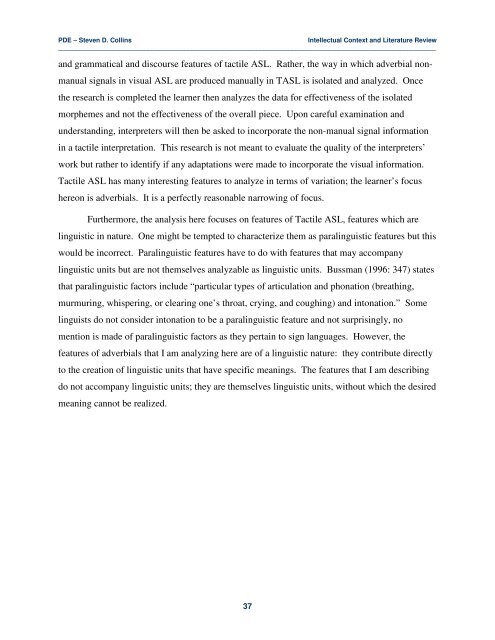Adverbial Morphemes in Tactile ASL - Gallaudet University
Adverbial Morphemes in Tactile ASL - Gallaudet University
Adverbial Morphemes in Tactile ASL - Gallaudet University
Create successful ePaper yourself
Turn your PDF publications into a flip-book with our unique Google optimized e-Paper software.
PDE – Steven D. Coll<strong>in</strong>s<br />
Intellectual Context and Literature Review<br />
_________________________________________________________________________________________________________<br />
and grammatical and discourse features of tactile <strong>ASL</strong>. Rather, the way <strong>in</strong> which adverbial nonmanual<br />
signals <strong>in</strong> visual <strong>ASL</strong> are produced manually <strong>in</strong> T<strong>ASL</strong> is isolated and analyzed. Once<br />
the research is completed the learner then analyzes the data for effectiveness of the isolated<br />
morphemes and not the effectiveness of the overall piece. Upon careful exam<strong>in</strong>ation and<br />
understand<strong>in</strong>g, <strong>in</strong>terpreters will then be asked to <strong>in</strong>corporate the non-manual signal <strong>in</strong>formation<br />
<strong>in</strong> a tactile <strong>in</strong>terpretation. This research is not meant to evaluate the quality of the <strong>in</strong>terpreters’<br />
work but rather to identify if any adaptations were made to <strong>in</strong>corporate the visual <strong>in</strong>formation.<br />
<strong>Tactile</strong> <strong>ASL</strong> has many <strong>in</strong>terest<strong>in</strong>g features to analyze <strong>in</strong> terms of variation; the learner’s focus<br />
hereon is adverbials. It is a perfectly reasonable narrow<strong>in</strong>g of focus.<br />
Furthermore, the analysis here focuses on features of <strong>Tactile</strong> <strong>ASL</strong>, features which are<br />
l<strong>in</strong>guistic <strong>in</strong> nature. One might be tempted to characterize them as paral<strong>in</strong>guistic features but this<br />
would be <strong>in</strong>correct. Paral<strong>in</strong>guistic features have to do with features that may accompany<br />
l<strong>in</strong>guistic units but are not themselves analyzable as l<strong>in</strong>guistic units. Bussman (1996: 347) states<br />
that paral<strong>in</strong>guistic factors <strong>in</strong>clude “particular types of articulation and phonation (breath<strong>in</strong>g,<br />
murmur<strong>in</strong>g, whisper<strong>in</strong>g, or clear<strong>in</strong>g one’s throat, cry<strong>in</strong>g, and cough<strong>in</strong>g) and <strong>in</strong>tonation.” Some<br />
l<strong>in</strong>guists do not consider <strong>in</strong>tonation to be a paral<strong>in</strong>guistic feature and not surpris<strong>in</strong>gly, no<br />
mention is made of paral<strong>in</strong>guistic factors as they perta<strong>in</strong> to sign languages. However, the<br />
features of adverbials that I am analyz<strong>in</strong>g here are of a l<strong>in</strong>guistic nature: they contribute directly<br />
to the creation of l<strong>in</strong>guistic units that have specific mean<strong>in</strong>gs. The features that I am describ<strong>in</strong>g<br />
do not accompany l<strong>in</strong>guistic units; they are themselves l<strong>in</strong>guistic units, without which the desired<br />
mean<strong>in</strong>g cannot be realized.<br />
37
















